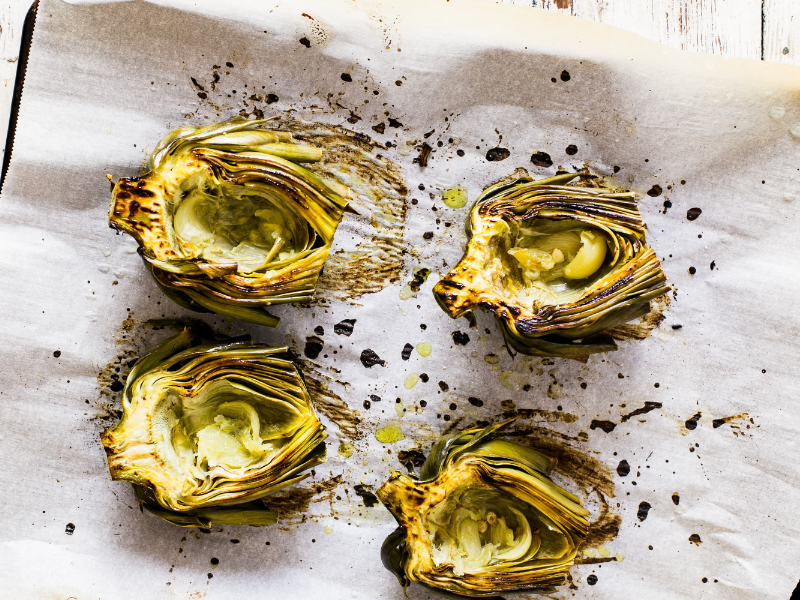Artichokes are the kind of vegetable that lots of people never try in their entire lives. But how do you know that you are not losing on this delicacy? It is needless to say that they may be hard to find at your local grocery store, and if you get some, you may get stuck during the preparation. Let us lead you through the crucial parts of the whole process, so you will never mess up this precious vegetable again.
Ingredients (2 servings):
- 4 whole artichokes, trimmed and cut in half
- 1 tablespoon (15 ml) of lemon juice
- 8 tablespoons (120 g) of unsalted butter
- 8 cloves of garlic
- 2 teaspoons (10 g) of lemon zest
- 2 teaspoons (10 g) of kosher salt
- 2 teaspoons (10 g) of freshly ground black pepper
- 2 tablespoons (30 ml) of olive oil
- 1 lemon, cut into wedges for serving
Steps:
- Sourcing Your Artichokes
- Getting Prepared for Cooking
- Cooking Sous Vide – Temperatures and Time
- Finishing and Serving Options
Step 1: Sourcing Your Artichokes
Seasonality
Sometimes, the artichokes are harder to find, but when they are freshly in stock at a grocery store, or you spot them at your local farmers market, you need to make sure to select only the best ones. It is always better to buy artichokes that were grown locally and picked in the right season of the year, which would be dependent on the place where you live. Generally speaking, the best quality you can get is at the beginning of the spring around March, and the harvest can last almost until July.
Visual Appearance
The first thing you should do is to pick artichokes up and weigh them in your hands. They should feel dense and firm. The leaves must be deep green, sometimes with purple shades, compactly attached, and there should be no sign of discoloration or any black marks. When you squeeze the artichoke lightly, the leaves should squeak. The older ones will be dry, rubbery, and have damaged or cracked leaves.
Size
Artichokes come in different sizes, so you need to evaluate the intended later use and your skills before you buy them. If you are looking for a bigger and meatier heart and you are willing to spend little extra time of trimming, go for the large and heavy ones. The smaller ones or even baby artichokes are much easier to clean. You can use and eat almost the whole head, which makes it a lot easier for beginners, and it does not require any special skills.
Step 2: Getting Prepared for Cooking
Here comes the most challenging part. People who want to try artichokes for the first time see all the trimming and cleaning as a big test. It is no surprise as it takes some serious work to remove all the inedible parts before you can start cooking. On the other hand, the only tool you will need here is your pairing knife. It is necessary to say that every time you will be handling the artichokes, you want to prevent them from going black. You should prepare a bowl of water and add a tablespoon of lemon juice for this reason. Wash your artichokes in the water bath beforehand to get rid of any residual dirt or impurities. You can keep the trimmed artichokes in there until they are needed so they will not lose their color.
Trimming
Start with the stem. You may break it off, or cut right at the section, where it connects to the head of the artichoke. Do not throw the stem away. It is perfectly edible when you peel the skin off and keep only the inside tender part. And how to get a perfectly clean artichoke heart? Cut two-thirds of the leaves from the top of the head. That reveals the inner structure of the artichoke and all the brighter green leaves. You may also see the hairy part called a choke, which the name artichoke was derived from. Place the head into your one hand and follow the circumference of the artichoke with your knife all around. Peel off all the tough dark green leaves slowly, tilt your blade as you progress lower, ending in the part where the stem was connecting. If done correctly, you will get rid of most of the tough leaves, leaving you with bright green or even yellowish edible center. Then cut the rest into two halves, so it will be easier to see where the meat is and what more you should trim. Get rid of the inside fuzzy part (choke), which is not edible, and which you may genuinely choke on later when it was left attached. When done, immediately plunge all the clean parts into the lemon water to prevent any discoloration and also to remove any residual impurities.
If you had a luck to find the baby artichokes, the only thing needed is to cut about a half-inch (1.25 cm) from the top of the head, peel the skin from the stem using a potato peeler and split them in half. You do not need to remove the small and undeveloped choke, and you can keep almost all the young leaves that are edible.
Seasoning
Place your artichoke halves and trimmed stems onto a cutting board and season them properly with salt and freshly ground black pepper. Add a pinch of lemon zest and squeeze out a few drops of lemon juice on each of them. Place a tablespoon of butter and one garlic clove inside of each of the hearts. Unlike when you are preparing a steak, the butter here is essential to help the artichoke to cook properly, and you do not need to be worried about diluting the flavor. Place all your seasoned artichokes into a sous vide bag, seal it, and you are ready for cooking.
Step 3: Cooking Sous Vide – Temperatures and Time
The cooking of the artichokes is undoubtedly the most straightforward task in the whole process, so there is not much to emphasize here. The only thing to mention is that the cooking time and temperature differ entirely from the other kinds of green vegetables, and this is because of its nature. It is actually an undeveloped flower of the artichoke plant from the thistle family.
You can see the temperature range to achieve results to your liking below. You may also use your sous vide application if your device manufacturer provides one.
180 °F (82 °C) – 190 °F (88 °C) for 2-3 hours
You can choose the lower temperatures if you like your vegetables to keep some structure an have a slight bite to them (al-dente). The higher the temperature gets, the softer your artichokes will be in the end.
Step 4: Finishing and Serving Options
Once the artichokes have spent the required time in the water bath, it is the right time to get them ready for serving. Open the bag, pour the melted butter and the garlic into a small pot and keep it aside. Fish the artichokes carefully out, place them on a paper towel, and pat them dry all over. Preheat your cast-iron skillet until it starts smoking and add a teaspoon of olive oil. Place in your artichokes with the cut side facing down and let them turn brown. In the meantime, blend the garlic-butter mixture with a hand blender to a smooth thin puree. If needed, season it with salt, freshly ground pepper, a bit of lemon juice or zest to your taste.


